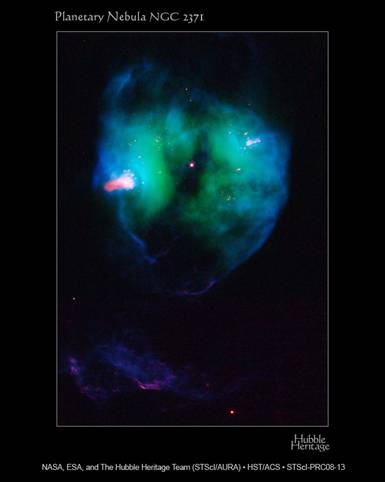15 March 2008

NASA’s Hubble Space Telescope (HST) recently took exquisite images of a dying Sun-like star, revealing fine details of the fascinating cloud of gas and dust that surrounds the exposed blazing core of the star.
The object, designated NGC 2371, is known as a planetary nebula. The remnant star shining at the center of NGC 2371 is the extremely hot core of the progenitor star, now stripped of its outer gaseous envelope. Its surface temperature is over 130,000 degrees Celsius! NGC 2371 lies about 4,300 light-years away in the zodiacal constellation Gemini, the Twins.
There are prominent pink clouds lying on opposite sides of the central star. Their color indicates that they are relatively cool and dense, compared to the rest of the gas in the nebula.
The numerous, very small pink dots mark relatively dense and small knots of gas, which are also located diametrically opposite, with respect to the star. These features appear to represent the ejection of gas from the star along a specific direction. The jet's direction has changed through the past few thousand years. Astronomers propose that this behavior could be due to the possible presence of a companion star orbiting the observable central star.
A planetary nebula is an expanding cloud of gas ejected from a low-mass star during the end throes of its life. The nebula glows due to ultraviolet radiation emitted by the hot central star. By the cosmic time scale, planetary nebulae are very short-lived. In only a few tens of thousands of years they disperse into space. The central star will then gradually cool down, turning into a white dwarf, the final stage of evolution for most stars.
The term ‘planetary nebula’ was coined by Sir William Herschel, the discoverer of the planet Uranus, as these nebulae somewhat resemble the fuzzy disc of Uranus, when viewed through a small telescope.
The image is a composite of images obtained by Hubble’s WFPC2 instrument. Four filters were used to sample narrow wavelength ranges matching the emission of specific chemical elements. The color is due to assigning different hues (colors) to each monochromatic image.
Further Reading
Last Confessions of a Dying Star
http://hubblesite.org/newscenter/archive/releases/2008/13/
Aymen Mohamed Ibrahem
Senior Astronomy Specialist